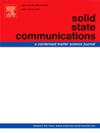双轴应变对有缺陷的 Ti3C2 Tx(T = F、O、OH)二氧化铀光学响应的调节作用
IF 2.1
4区 物理与天体物理
Q3 PHYSICS, CONDENSED MATTER
引用次数: 0
摘要
MXenes在吸附放射性元素和保护放射性物质表面方面具有潜在的应用前景。保持完整性对于实际应用非常重要。因此,需要一种有效的方法来检测孔缺陷和应变条件。本文基于第一性原理计算了Ti3C2T2 (T = F, O, OH) MXenes的电子结构和光学性质,给出了Ti3C2T2 (T = F, O, OH) MXenes的孔缺陷和应变条件的光学检测系统结果。空穴缺陷的引入影响了周围官能团的化学键合,从- 4%到4%的双轴应变引起的键合变形可以忽略不计。不同应变下键长变化均小于0.05 Å。由于官能团的电子态分布在远离费米能级的地方,因此在紫外频率范围内的吸收光谱对空穴缺陷和应变条件表现出明显的调制效应。已经建立了数量关系。我们的结果可以用于检测Ti3C2T2 (T = F, O, OH) MXenes的缺陷结构和应变条件。本文章由计算机程序翻译,如有差异,请以英文原文为准。
Modulation of biaxial strains on the optical responses of defective Ti3C2 Tx (T = F, O, OH) MXenes
MXenes have potential applications for adsorbing radioactive elements and protecting surfaces of radioactive materials. Keeping integrity is important for practical applications. Thus, an efficient way for detecting hole defects as well as strain conditions becomes required. Here based on first-principles calculations on the electronic structures and optical properties, we present a systematic result for optical detections on hole defects as well as strain conditions of Ti3C2T2 (T = F, O, OH) MXenes. Introduction of hole defects affects the chemical bondings of surrounding functional groups, and biaxial strains from −4 % to 4 % causes negligible bonding distortions. The change in bonding lengths under different strains is below 0.05 Å. Since the electronic states of functional groups distribute deeply away from the Fermi level, the absorption spectra in the ultraviolet frequency range show obvious modulation effects for hole defects and strain conditions. A quantitative relationship has been established. Our results can be used for detecting both the defect structures and strain conditions of Ti3C2T2 (T = F, O, OH) MXenes.
求助全文
通过发布文献求助,成功后即可免费获取论文全文。
去求助
来源期刊

Solid State Communications
物理-物理:凝聚态物理
CiteScore
3.40
自引率
4.80%
发文量
287
审稿时长
51 days
期刊介绍:
Solid State Communications is an international medium for the publication of short communications and original research articles on significant developments in condensed matter science, giving scientists immediate access to important, recently completed work. The journal publishes original experimental and theoretical research on the physical and chemical properties of solids and other condensed systems and also on their preparation. The submission of manuscripts reporting research on the basic physics of materials science and devices, as well as of state-of-the-art microstructures and nanostructures, is encouraged.
A coherent quantitative treatment emphasizing new physics is expected rather than a simple accumulation of experimental data. Consistent with these aims, the short communications should be kept concise and short, usually not longer than six printed pages. The number of figures and tables should also be kept to a minimum. Solid State Communications now also welcomes original research articles without length restrictions.
The Fast-Track section of Solid State Communications is the venue for very rapid publication of short communications on significant developments in condensed matter science. The goal is to offer the broad condensed matter community quick and immediate access to publish recently completed papers in research areas that are rapidly evolving and in which there are developments with great potential impact.
 求助内容:
求助内容: 应助结果提醒方式:
应助结果提醒方式:


